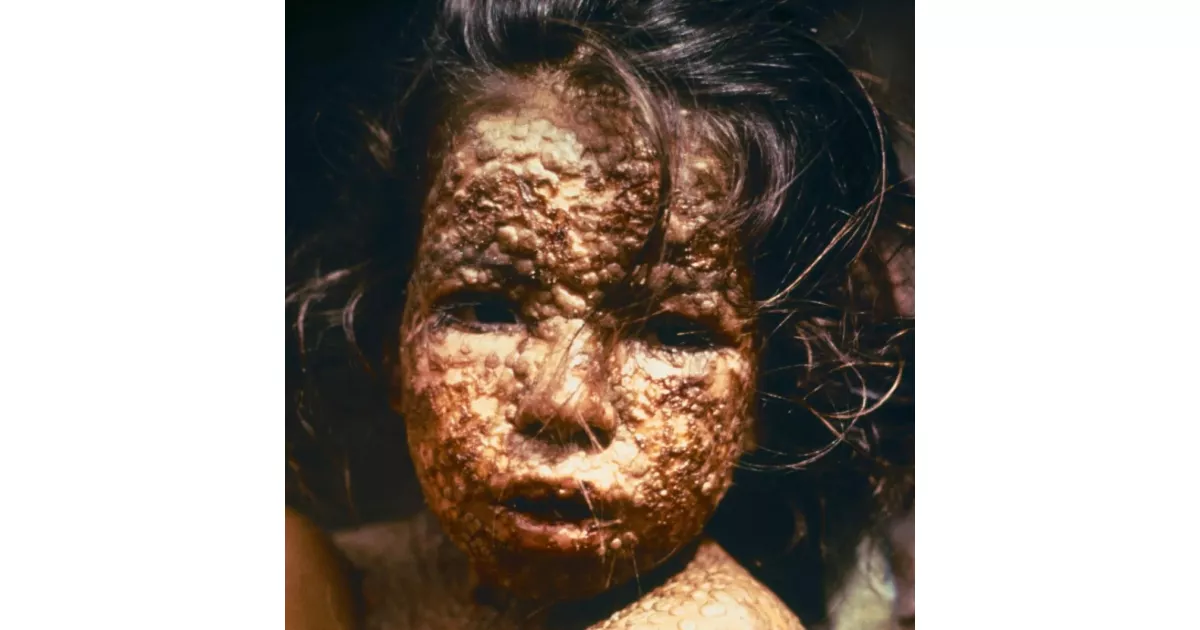Smallpox, a deadly infectious disease caused by the variola virus, was successfully eradicated globally by 1980. The World Health Organization certified its eradication after the last naturally occurring case was identified in 1977, making it the first and only human disease to be completely eliminated.
1900: Smallpox Elimination in Northern Europe
By 1900, several countries in Northern Europe successfully eliminated smallpox due to coordinated vaccination efforts and disease control measures.
1914: Reduced Smallpox Incidence in Industrialized Nations
By 1914, most industrialized countries witnessed a significant decrease in smallpox cases, indicating the effectiveness of vaccination campaigns and public health interventions.
1947: Soviet Union Establishes Smallpox Weapons Facility
The Soviet Union established a smallpox weapons factory in Zagorsk, about 75 kilometers northeast of Moscow, in 1947.
1950: Pan American Health Organization's Eradication Effort
In 1950, the Pan American Health Organization (PAHO) launched the first hemisphere-wide initiative to eradicate smallpox. This campaign led to the elimination of smallpox in most American countries, marking a significant step towards global eradication.
1954: Smallpox Vials Origin
This date represents the year the smallpox samples found in the NIH facility were dated, indicating when they were likely stored.
1958: Professor Viktor Zhdanov's Call for Global Eradication
In 1958, Professor Viktor Zhdanov, the Deputy Minister of Health for the USSR, urged the World Health Assembly to initiate a worldwide effort to eliminate smallpox.
1959: World Health Assembly's Resolution for Global Eradication
The World Health Assembly, in 1959, adopted Resolution WHA11.54, marking the beginning of a globally coordinated endeavor to eradicate smallpox. At this time, smallpox was a major public health concern, claiming 2 million lives annually.
July 1963: Smallpox Outbreak in Stockholm
In May-July 1963, Stockholm, Sweden experienced a smallpox outbreak traced back to a Swedish sailor returning from the Far East. The outbreak was effectively contained through quarantine measures and targeted vaccination of the local population.
1966: Formation of the Smallpox Eradication Unit
An international team, the Smallpox Eradication Unit, was established in 1966, spearheaded by the American epidemiologist Donald Henderson. This marked a significant escalation in the global fight against smallpox.
1967: WHO Intensifies Smallpox Eradication Efforts
In 1967, when smallpox cases reached 15 million annually, the WHO intensified efforts to eradicate the disease.
1967: Sequencing of Variola Major Virus
The current reference genome sequence for the variola major virus, responsible for smallpox, originates from a strain found in India in 1967.
1971: Weaponized Smallpox Outbreak at Aral Sea Facility
An outbreak of weaponized smallpox occurred in 1971 at a Soviet facility located on an island in the Aral Sea during weapons testing, as confirmed by General Prof. Peter Burgasov, a former high-ranking official involved in the Soviet biological weapons program.
1972: US Discontinues Routine Smallpox Vaccination
Due to the declining smallpox cases and risks associated with vaccination, the United States discontinued routine smallpox vaccination for children in 1972.
1972: The Last Major European Smallpox Outbreak
The last major smallpox outbreak in Europe occurred in Yugoslavia in 1972. The outbreak originated from a pilgrim returning from the Middle East and led to 175 cases and 35 deaths. Authorities implemented strict measures, including martial law, quarantine, and mass vaccinations with WHO's support, to contain the outbreak within two months.
1973: Shift in Vaccine Production
By 1973, a significant shift occurred in the global production of the smallpox vaccine. While initially, the majority of the vaccine was supplied by the Soviet Union and the United States, a remarkable development took place with developing countries taking the lead. This shift highlighted the growing capacity and commitment of developing nations in the fight against smallpox.
October 1975: The Last Naturally Occurring Case of Variola major
In October 1975, a three-year-old Bangladeshi girl, Rahima Banu, became the last known case of the more lethal Variola major, signaling significant progress in the effort to eradicate smallpox.
1976: US Healthcare Workers No Longer Routinely Vaccinated
The US stopped routine smallpox vaccination for healthcare workers in 1976 as eradication efforts progressed, and the risks associated with the vaccine outweighed the benefits.
October 1977: Last Naturally Occurring Smallpox Case
In October 1977, the last naturally occurring case of smallpox was diagnosed, marking a significant step towards its eradication.
October 1977: The Last Naturally Occurring Case of Variola minor
On October 26, 1977, Ali Maow Maalin, a hospital cook in Merca, Somalia, was diagnosed with the last naturally occurring case of indigenous smallpox (Variola minor). This event marked a pivotal moment in the global eradication campaign.
October 1977: Last Variola Minor Case
The last known case of variola minor, a milder form of smallpox, was recorded in October 1977 in Somalia.
September 1978: Last Case of Smallpox in the UK
The world's last case of smallpox occurred in the United Kingdom in 1978, when Janet Parker, a medical photographer at the University of Birmingham Medical School, contracted the disease and tragically passed away on September 11, 1978.
December 1979: Global Eradication of Smallpox Certified
After rigorous verification activities, a commission of leading scientists officially declared the world free of smallpox on December 9, 1979.
May 1980: Smallpox Officially Eradicated
Following the last case of variola minor in 1977, smallpox was officially declared eradicated worldwide in May 1980.
May 1980: World Health Assembly Endorses Smallpox Eradication
On May 8, 1980, the World Health Assembly formally endorsed the declaration of smallpox eradication, solidifying the monumental achievement of completely eradicating a disease.
1980: WHO Certifies Global Eradication of Smallpox
The World Health Organization (WHO) declared the global eradication of smallpox in 1980, making it the first human disease to be eradicated.
1986: Global Cessation of Routine Smallpox Vaccination
By 1986, routine smallpox vaccination had been discontinued in all countries worldwide, marking a significant achievement in global health.
1986: WHO Recommends Destruction of Smallpox Virus
Concerned about the potential risks associated with the remaining smallpox virus stocks, the WHO first recommended the destruction of all known samples in 1986.
1990: US Military Recruits No Longer Routinely Vaccinated
In 1990, the US military stopped routine smallpox vaccination for recruits, except those deploying to high-risk areas, reflecting the diminishing threat of the disease.
1991: Inspection of Soviet Bioweapons Facilities
In 1991, due to international pressure, the Soviet Union allowed a team from the United States and Britain to inspect four of their biological weapons facilities. However, the inspection was met with resistance and denials, and the inspectors were eventually asked to leave.
1992: Allegations of Soviet Smallpox Stockpile
Ken Alibek, a Soviet defector, claimed in 1992 that the Soviet bioweapons program had produced up to twenty tons of weaponized smallpox at Zagorsk, potentially engineered for vaccine resistance, stored with delivery warheads. These allegations have yet to be verified.
December 1993: Initial Date Set for Smallpox Virus Destruction Postponed
Initially, the WHO set December 30, 1993, as the date for destroying all remaining smallpox virus stocks. However, this decision faced resistance and was eventually postponed.
1997: Russia Consolidates Smallpox Samples to Vector Institute
In 1997, the Russian government declared that it had moved all its remaining smallpox samples to the Vector Institute in Koltsovo. This raised concerns among U.S. officials that former Soviet scientists might provide expertise on smallpox weaponization to other nations or terrorist groups.
June 1999: Second Postponement of Smallpox Virus Destruction
The date for destroying the remaining smallpox virus stocks was further postponed to June 30, 1999, amid continued debates and opposition from certain countries.
2002: Temporary Retention of Smallpox Virus Stocks Permitted
Facing pressure from the United States and Russia, the World Health Assembly in 2002 agreed to allow the temporary retention of smallpox virus stocks for specific research purposes, despite concerns from some scientists and the WHO.
2002: Artificial Synthesis of Vaccinia Virus
Scientists at the NIH successfully synthesized the vaccinia virus, a relative of the smallpox virus, in 2002, raising concerns about potential misuse of the technology.
March 31, 2003: Discovery of Smallpox Scabs Offers Insights into Vaccination History
The discovery of smallpox scabs in an envelope within an 1888 book on Civil War medicine in Santa Fe, New Mexico, on March 31, 2003, provided scientists at the CDC with a unique opportunity to study the historical practices of smallpox vaccination in the United States.
2004: WHO Committee Recommends Genetic Marker for Smallpox
In 2004, a WHO advisory committee recommended allowing genetic modification of remaining variola samples to add a green fluorescent protein (GFP) marker, aiming to aid treatment research.
2005: WHA Defers Decision on Smallpox Genetic Modification
The World Health Assembly (WHA) in 2005 postponed a decision on the proposed GFP marker insertion into the variola virus, choosing to evaluate individual research proposals instead.
August 31, 2007: ACAM2000 Smallpox Vaccine Approved
The FDA approved the ACAM2000 smallpox vaccine on August 31, 2007, providing an alternative to the older Dryvax vaccine for use in specific circumstances, like military personnel and national stockpiles.
2007: Evidence Presented for Smallpox Viability in 1789
In 2007, researcher Christopher Warren presented evidence suggesting the British smallpox virus could have remained viable in 1789, supporting the theory of its use against indigenous Australians.
2010: Dispute over Smallpox as a Weapon Against Indigenous Australians
In 2010, Professor Jack Carmody argued that a rapid disease outbreak among indigenous Australians in 1789, often attributed to smallpox, was more likely chickenpox. This challenged an earlier theory suggesting British forces used smallpox as a biological weapon.
2010: WHO Expert Review on Smallpox Virus Retention
In 2010, a team of public health experts appointed by the WHO conducted a comprehensive review and concluded that the United States and Russia's continued retention of smallpox virus stocks served no essential public health purpose, further fueling the debate over their destruction.
2011: Rinderpest Eradicated
Following smallpox's eradication, rinderpest, a disease affecting even-toed ungulates, was declared eradicated in 2011, making them the only two eradicated infectious diseases.
2013: Chickenpox Hypothesis Gains Support
In 2013, Professor Jack Carmody reiterated his support for the chickenpox hypothesis regarding the 1789 outbreak among indigenous Australians, adding that chickenpox was known to be present in the Sydney Cove colony at the time.
July 1, 2014: Discovery of Smallpox Vials at NIH Facility
On July 1, 2014, six vials containing smallpox from 1954 were found in a cold storage room at an FDA laboratory located within the National Institutes of Health in Bethesda, Maryland.
February 24, 2015: CDC Destroys Smallpox Samples
After being transferred to the CDC in Atlanta, and studied, the smallpox samples from the NIH discovery were destroyed on February 24, 2015, under the observation of the World Health Organization.
2016: Horsepox Virus Synthesized
Researchers synthesized the horsepox virus in 2016 using publicly available data, raising ethical concerns and highlighting the potential for misuse of synthetic biology despite regulations.
2017: Horsepox Virus Recreation Raises Concerns
In 2017, scientists at the University of Alberta recreated an extinct horsepox virus, a close relative of smallpox. This achievement demonstrated that the variola virus (smallpox) could be recreated in a lab for about $100,000, raising concerns about the potential for malicious use.
July 2018: First FDA-Approved Smallpox Treatment
The US FDA approved tecovirimat in July 2018 as the first drug specifically for treating smallpox, offering a potential therapeutic option in case of re-emergence.
September 2019: Gas Explosion at Russian Smallpox Lab
In September 2019, a gas explosion occurred at the Russian lab storing smallpox samples, injuring a worker. The incident prompted a review of safety and containment procedures, even though the explosion didn't happen near the virus storage and no samples were compromised.
June 2021: Brincidofovir Approved for Smallpox Treatment
In June 2021, the United States approved brincidofovir for treating human smallpox caused by the variola virus, adding another potential treatment option.
Mentioned in this timeline
The Union of Soviet Socialist Republics USSR existed from to...

Martial law is the imposition of military rule in place...
India officially the Republic of India is a South Asian...

The World Health Organization WHO is a specialized agency of...
Russia officially the Russian Federation is a transcontinental country spanning...

Books are a means of storing information as text or...
Trending
7 months ago Arkansas Razorbacks Dominate, Advance to NCAA Super Regionals: Fayetteville Celebrates Victory

7 months ago Lutnick's El Salvador crypto ties scrutinized amid Trump Commerce Secretary's stake.

Brenda Lee known as Little Miss Dynamite is an American singer prominent in rockabilly pop country and Christmas music Achieving...

2 months ago Barron Trump's Height, Dating Life, and Eric Trump's Advice Spark Discussion

7 months ago Elysée Denies Macron Slapped by Brigitte in Vietnam; Claims Playful Moment

4 months ago Colorado Lottery results: Pick 3 Midday and Evening winning numbers for August 14, 2025.
Popular

Candace Owens is an American conservative political commentator and author...
Matt and Ross Duffer known as the Duffer Brothers are...

Ilhan Omar is an American politician currently serving as the...

XXXTentacion born Jahseh Dwayne Ricardo Onfroy was a controversial yet...

Tom Cotton is an American politician and Army veteran currently...
The Kennedy Center Honors are annual awards recognizing individuals and...
